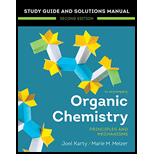
Concept explainers
(a)
Interpretation:
To accurately depict the given ball-stick model, the dash-wedge notations in the given line structure are to be added.
Concept introduction:
The dash-wedge notations are used to represent the three-dimensional arrangement of atoms or groups of molecules in plane of paper. There are three types of lines used for such arrangements, straight line, dash line, and wedge line. The straight line represents the bond is in the plane of the paper. The dash line represents the bond pointing away from the observer, that is, below the plane of paper. The wedge line represents the bond pointing towards the observer that is above the plane of paper.
Answer to Problem 2.36P
The dash-wedge notations in the given line structure is:
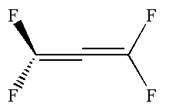
Explanation of Solution
The given ball-stick model and the line structure are:

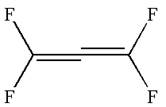
In the given ball-stick model, the yellow balls represent fluorine atoms and black balls are carbon atoms. The fluorine atoms on the left side appear in the plane of the paper. Thus, these fluorine atoms will be represented by straight lines. The two fluorine atoms on the right side are arranged such that, one fluorine atom is above the plane of paper and other is below. The one which is above the plane will be represented by a wedge bond while the one which is below the plane of the paper will be represented by a dash line.
Hence dash-wedge notation for the given molecules is shown below:
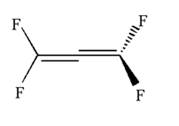
The dash-wedge notation in the given line structure is added on the basis of three dimensional arrangement given in ball-stick model.
(b)
Interpretation:
To accurately depict the given ball-stick model, the dash-wedge notations in the given line structure are to be added.
Concept introduction:
The dash-wedge notations are used while representing the three dimensional arrangement of atoms or groups of molecules on the plane of paper. There are three types of lines used for such arrangements, straight line, dash line, and wedge line. The straight line represents the bond that is in the plane of the paper. The dash line represents the bond pointing away from the observer that is below the plane of paper. The wedge line represents the bond pointing towards the observer that is above the plane of paper.
Answer to Problem 2.36P
The dash-wedge notations in the given line structure is:
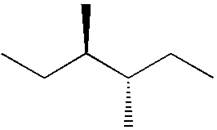
Explanation of Solution
The given ball-stick model and its line structure are:

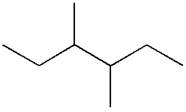
In the given ball-stick model, the white balls represent hydrogen atoms while black balls are carbon atoms. The longest continuous chain is of six carbon atoms having two methyl substituents at
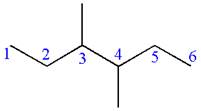
If the chain is numbered from left to right, the methyl group at
Hence, the dash-wedge notation for the given molecules is shown below:
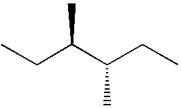
The dash-wedge notation in the given line structure is added on the basis of three dimensional arrangement given in ball-stick model.
(c)
Interpretation:
To accurately depict the given ball-stick model, the dash-wedge notations in the given line structure are to be added.
Concept introduction:
The dash-wedge notations are used while representing the three dimensional arrangement of atoms or groups of molecules on the plane of paper. There are three types of lines used for such arrangements, straight line, dash line, and wedge line. The straight line represents the bond is in the plane of paper. The dash line represents the bond pointing away from the observer that is below the plane of paper. The wedge line represents the bond pointing towards the observer that is above the plane of paper.
Answer to Problem 2.36P
The dash-wedge notations in the given line structure is:

Explanation of Solution
The given ball-stick model and its line structure are:
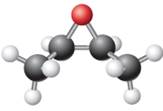

In the given ball-stick model the white balls represent hydrogen atoms, black balls represents carbon atoms and the red ball is an oxygen atom. The two carbon atoms that are directly bonded to the oxygen atom are in the plane of paper. Each of these carbon atoms has one methyl substituent and one hydrogen atom attached. Two methyl substituents points towards the observer, while the hydrogen atoms are pointing away from the observer. The bond towards the observer is considered as above the plane of the paper and is represented by wedge bond. The bond away from the observer is considered as below the plane of the paper and is represented by dash bond.
Hence dash-wedge notation for the given molecules is shown below:

The dash-wedge notation in the given line structure is added on the basis of three dimensional arrangement given in ball-stick model.
(d)
Interpretation:
To accurately depict the given ball-stick model, the dash-wedge notations in the given line structure are to be added.
Concept introduction:
The dash-wedge notations are used while representing the three dimensional arrangement of atoms or groups of molecules on the plane of paper. There are three types of lines used for such arrangements, straight line, dash line, and wedge line. The straight line represents the bond is in the plane of the paper. The dash line represents the bond pointing away from the observer that is below the plane of paper. The wedge line represents the bond pointing towards the observer that is above the plane of paper.
Answer to Problem 2.36P
The dash-wedge notations in the given line structure is:
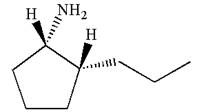
Explanation of Solution
The given ball-stick model and its line structure are:
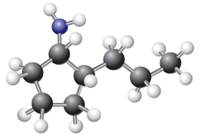

In the given ball-stick model the white balls represent hydrogen atoms, black balls are carbon atoms, and the blue ball is a nitrogen atom. The cyclopentane ring is on the plane of paper having two substituents. The
The
The second substituent is propyl group which points away from the observer and the hydrogen atoms bonded to the same carbon having propyl group is pointed towards observer.
The bond towards the observer is considered as above the plane of the paper and is represented by a wedge line. The bond away from the observer is considered as below the plane of the paper and is represented by dash line
Hence dash-wedge notation for the given molecules is shown below:
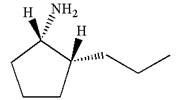
The dash-wedge notation in the given line structure is added on the basis of three dimensional arrangement given in ball-stick model.
Want to see more full solutions like this?
Chapter 2 Solutions
Organic Chemistry: Principles And Mechanisms: Study Guide/solutions Manual (second)
- Predict the products of this organic reaction: O CH3 + H2O + HCI A A? CH3-CH2-C-N-CH3 Specifically, in the drawing area below draw the condensed structure of the product, or products, of this reaction. If there's more than one product, draw them in any arrangement you like, so long as they aren't touching. If there aren't any products because this reaction won't happen, check the No reaction box under the drawing area. No Reaction Click anywhere to draw the first atom of your structure.arrow_forwardWhat is the missing reactant in this organic reaction? R+ HO-C-CH2-CH3 0= CH3 CH3 —CH, C−NH—CH CH3 + H₂O Specifically, in the drawing area below draw the condensed structure of R. If there is more than one reasonable answer, you can draw any one of them. If there is no reasonable answer, check the No answer box under the drawing area. Note for advanced students: you may assume no products other than those shown above are formed. No Answer Click anywhere to draw the first atom of your structure. €arrow_forward个 CHEM&131 9267 - $25 - Intro to Mail - Hutchison, Allison (Student x Aktiv Learnin https://app.aktiv.com Draw the product of the reaction shown below. Ignore inorganic byproducts. + Na2Cr2O7 Acetone, H2SO4 Type here to search Dryng OH W Prarrow_forward
- Predict the products of this organic reaction: OH + NaOH A? Specifically, in the drawing area below draw the skeletal ("line") structure of the product, or products, of this reaction. (If there's more than one product, draw them in any arrangement you like, so long as they aren't touching.) If there aren't any products because this reaction won't happen, check the No reaction box under the drawing area. No reaction Click and drag to start drawing a structure. ✓ Sarrow_forwardPredict the products of this organic reaction: CH3-C-O-CH2-CH2-C-CH3 + H₂O ? A Specifically, in the drawing area below draw the condensed structure of the product, or products, of this reaction. (If there's more than one product, draw them in any arrangement you like, so long as they aren't touching.) If there aren't any products because this reaction won't happen, check the No reaction box under the drawing area. No reaction Click anywhere to draw the first atom of your structure. :☐ darrow_forwardDE d. Draw an arrow pushing mechanism for the following IN O CI N fo 人 P Polle DELL prt sc home end ins F5 F6 F7 F8 F9 F10 F11 F12arrow_forward
- Predict the products of this organic reaction: + H₂O H* ? A Specifically, in the drawing area below draw the skeletal ("line") structure of the product, or products, of this reaction. (If there's more than one product, draw them in any arrangement you like, so long as they aren't touching.) If there aren't any products because this reaction won't happen, check the No reaction box under the drawing area. No Reaction Click and drag to start drawing a structure.arrow_forwardPredict the major organic products of the reaction below and draw them on right side of the arrow. If there will be no significant reaction, check the box below the drawing area instead. C Cl CH, OH There will be no significant reaction. + pyridine G Click and drag to start drawing a structure.arrow_forwardWhat is the missing reactant in this organic reaction? H R+ H2O Δ OH 0= CH3-CH-O-CH3 + CH3-C-OH Specifically, in the drawing area below draw the condensed structure of R. If there is more than one reasonable answer, you can draw any one of them. If there is no reasonable answer, check the No answer box under the drawing area. No Answer Click anywhere to draw the first atom of your structure. dyarrow_forward
- You are trying to determine whether the following organic reaction can be done in a single synthesis step. If so, add any missing reagents or conditions in the drawing area below. If it isn't possible to do this reaction in a single synthesis step, check the box below the drawing area instead. Note for advanced students: if you have a choice of reagents to add, you should choose the least reactive and most economical reagents possible. Cl It isn't possible to do this reaction in a single synthesis step. + T OHarrow_forwardPredict the products of this organic reaction: CH3 O CH3-CH-C-O-CH2-CH2-CH3 + H₂OH+ Η ? A Specifically, in the drawing area below draw the condensed structure of the product, or products, of this reaction. (If there's more than one product, draw them in any arrangement you like, so long as they aren't touching.) If there aren't any products because this reaction won't happen, check the No reaction box under the drawing area. No Reaction Click anywhere to draw the first atom of your structure.arrow_forward€ CH3-CH-C-O-CH2-CH2-CH3 + NaOH A? Specifically, in the drawing area below draw the condensed structure of the product, or products, of this reaction. (If there's more than one product, draw them in any arrangement you like, so long as they aren't touching.) If there aren't any products because this reaction won't happen, check the No reaction box under the drawing area. Predict the products of this organic reaction: CH3 O Click anywhere to draw the first atom of your structure. No reaction ✓ Garrow_forward
 Organic Chemistry: A Guided InquiryChemistryISBN:9780618974122Author:Andrei StraumanisPublisher:Cengage Learning
Organic Chemistry: A Guided InquiryChemistryISBN:9780618974122Author:Andrei StraumanisPublisher:Cengage Learning Chemistry for Today: General, Organic, and Bioche...ChemistryISBN:9781305960060Author:Spencer L. Seager, Michael R. Slabaugh, Maren S. HansenPublisher:Cengage Learning
Chemistry for Today: General, Organic, and Bioche...ChemistryISBN:9781305960060Author:Spencer L. Seager, Michael R. Slabaugh, Maren S. HansenPublisher:Cengage Learning

